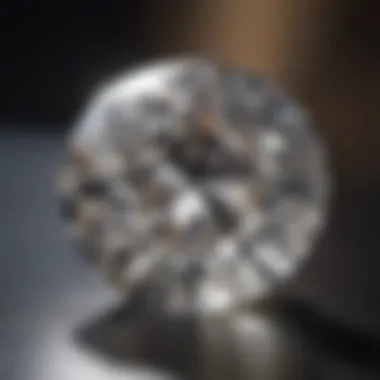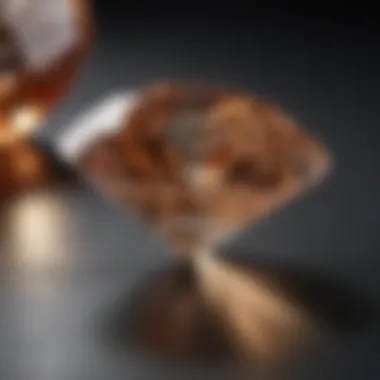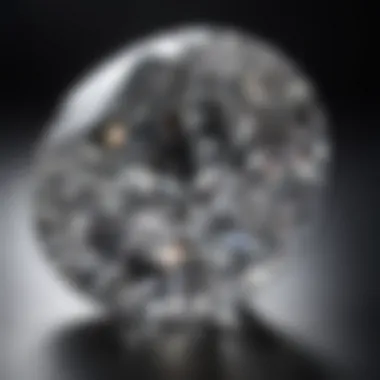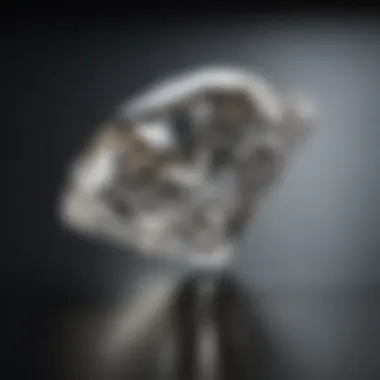Understanding the 55 Carat Diamond: An In-Depth Guide


Intro
The 55-carat diamond stands as one of the most striking examples of nature's craftsmanship in the realm of gemstones. This article aims to illuminate the many facets of these magnificent diamonds, offering a comprehensive overview that caters to gemstone enthusiasts, collectors, and those who design exquisite jewelry. With a keen focus on the unique properties, valuation, and cultural significance of diamonds of this size, the discussion will unfold a narrative that highlights their allure and importance.
Gemstone Overview
Definition and Origins
A 55-carat diamond refers to a diamond weighing 55 carats, which equates to approximately 11 grams. Such substantial gemstones are rare, often originating from significant deposits found in places such as South Africa and Russia. Diamonds form under extreme pressure and high temperatures deep within Earth’s mantle over millions of years. The larger the diamond, the more intricate and fragile its journey from rough stone to gem becomes.
Historical Significance
Throughout history, diamonds have represented wealth, power, and luxury. The allure of diamonds can be traced back centuries, where they adorned the crowns of kings and queens. A 55-carat diamond has a resonance that echoes through the ages, often being the centerpiece of tales involving romance and extravagance. From the Hope Diamond to the Koh-i-Noor, significant diamonds have impacted cultures and narratives globally, influencing trade and social status.
Gemstone Properties
Hardness and Durability
Diamonds possess remarkable hardness, rated 10 on the Mohs scale, making them the hardest natural material known. This durability ensures that a 55-carat diamond can withstand everyday wear and tear, although care is still needed to maintain its brilliance. Generally, proper handling and avoiding harsh chemicals can prolong the clarity and shine of the diamond.
Color and Clarity
Color and clarity are two essential attributes used to evaluate diamonds. While the finest diamonds are colorless, many diamonds exhibit subtle hues, such as shades of yellow or brown. A 55-carat diamond can showcase varied colors that contribute to its overall value. Clarity refers to the presence of internal or external flaws, with higher clarity resulting in greater value. An eye-clean diamond will fetch a more premium price.
"Choosing the right diamond requires understanding the nuances of color and clarity, especially in larger carats."
With these insights, readers can appreciate the complexities involved in valuing a diamond of this magnitude.
The End
This overview provides just a glimpse into the fascinating world of the 55-carat diamond. As we continue to explore its characteristics, valuation, and cultural implications, this narrative will serve as a guiding light for those interested in acquiring or simply appreciating these remarkable gems.
Preface to the Carat Diamond
The world of gemstones is both fascinating and complex, particularly when it comes to diamonds. Among them, the 55-carat diamond stands out not only due to its substantial weight but also because of its unique attributes. Understanding this diamond provides insight not only into its physical characteristics but also into the emotional and economic value it carries. Diamonds of this size are not common; they represent a significant financial investment, a statement of luxury, and often, a symbol of personal milestones.
In this section, we will define what constitutes a 55-carat diamond, delve into the science that dictates diamond weight, and understand how it plays a pivotal role in discerning the quality and value of this exceptional gemstone.
What Constitutes a Carat Diamond?
A 55-carat diamond is simply a diamond that weighs 55 carats. The term 'carat' is a unit of weight that equates to 200 milligrams. Therefore, a 55-carat diamond weighs approximately 11 grams. It is essential to note that carat weight alone does not determine the diamond's value or appearance. Other characteristics, such as the diamond's cut, color, and clarity, are crucial in defining its overall quality and price.
When considering a 55-carat diamond, one must also take into account how its size affects its appearance. A diamond with a larger carat weight will often appear different depending on its cut. For example, a well-cut diamond can appear larger than one with the same weight but inferior cut quality. This diamond's shape (round, emerald, etc.) also greatly influences perception and preference among buyers.
The Science Behind Diamond Carat Weight
Understanding diamond carat weight is rooted in measurement. Carat weight reflects the size of the diamond, and it is one of the key factors in determining its value. However, the relationship between carat weight and perceived size can be confusing.
For diamonds, each carat is divided into 100 points. This means that a diamond weighing 55 carats is equivalent to 55 x 100 = 5500 points. As the carat weight increases, the price does not rise linearly; larger diamonds command a premium for their rarity.
The decision to purchase a diamond of such weight involves considerations of rarity and market trends. Larger diamonds are considerably scarcer than smaller ones, influencing both their price and desirability.
Understanding these nuances of carat not only helps in making informed purchases but also enhances appreciation for what a diamond of this scale represents in the broader context of the gemology.
The Characteristics of a Carat Diamond


The characteristics of a 55 carat diamond are crucial for understanding its value, appeal, and quality. Each element contributes to the overall beauty and significance of the diamond. Carat weight is just one factor among many that determine a diamond's allure. The cut, color, and clarity are also integral to its desirability. This section focuses on these attributes, which all play distinct roles in the world of high-value gemstones.
Cut: The Facets That Matter
The cut of a diamond refers to how well it has been shaped and polished. In the case of a 55 carat diamond, the quality of the cut is particularly essential. A well-executed cut defines how light interacts with the stone, influencing brilliance and sparkle.
There are various shapes for diamond cuts. Some of the most common include round, princess, and emerald cuts. Each shape has its own unique qualities that can affect visual appeal. For larger diamonds, like a 55 carat specimen, the precision of the cut becomes even more important. Any imperfection is magnified, and thus, a high-quality cut becomes vital to maintaining the diamond's overall value.
Factors to consider regarding cut quality:
- Proportions: The angles and dimensions must be precise to achieve optimal light reflection.
- Symmetry: Each facet should align perfectly with others to enhance beauty.
- Polish: A smooth and reflective surface contributes to brilliance.
Color: Assessing the Hue
Color in diamonds is often evaluated on a scale ranging from D (colorless) to Z (light yellow or brown). For a 55 carat diamond, even a slight tint can have significant effects on value. Colorless diamonds are generally more sought after, but some colors can be rare and desirable, such as pink or blue diamonds.
Assessing the hue requires careful evaluation under controlled lighting conditions. The goal is to determine the diamond's actual color in comparison to master stones.
Color grading is important because it inevitably influences the market price. Diamond buyers often seek stones with minimal color for higher-end pieces.
Clarity: Understanding Inclusions
Clarity refers to the presence of internal or external flaws known as inclusions and blemishes, respectively. The fewer the imperfections, the greater the clarity, which positively impacts the value of a diamond.
Given the large size of a 55 carat diamond, evaluating clarity is even more crucial. Inclusions might be less visible in smaller stones but become prominent in larger gems. Common clarity grades range from Flawless (no inclusions visible under 10x magnification) to Included (inclusions visible without magnification).
Understanding clarity involves:
- Types of Inclusions: Some include scratches, bubbles, or other internal irregularities experienced during formation.
- Location: The positioning of inclusions can affect how they are perceived visually.
- Impact on Value: Higher clarity grades typically command higher prices, while stones with noticeable inclusions may struggle for sale.
"Each characteristic of the 55 carat diamond shapes its market presence and affects collectors' desire, making it crucial to evaluate them thoroughly."
Evaluating the Value of a Carat Diamond
Understanding the value of a 55 carat diamond requires careful consideration of multiple factors. As diamonds of this magnitude are rare, their significance goes beyond mere carat weight. An expansive valuation framework includes market dynamics, potential as an investment, and other elements that influence resale value. This section examines these essential aspects in detail, providing valuable insights for collectors and enthusiasts.
Market Influences on Diamond Pricing
The pricing of diamonds, particularly larger specimens, is not static. Market dynamics shift based on demand and supply. Trends in luxury goods often dictate the price of larger diamonds. For instance, an increase in demand for eco-friendly and ethically sourced stones can impact prices significantly.
Economic factors also play a role. When economies are strong, luxury items, including large diamonds, tend to see a surge in demand. Conversely, during economic downturns, the appetite for high-value diamonds may diminish, leading to lower prices. Investors need to remain aware of these factors to make informed decisions. Additionally, marketing efforts from diamond companies also contribute to how diamonds are priced and perceived in the marketplace.
Investment Potential of Larger Diamonds
The 55 carat diamond represents not just a piece of jewelry but an investment opportunity. Larger diamonds historically retain value well. They can appreciate over time, especially if they possess excellent quality characteristics such as a good cut, color, and clarity. Collectors may regard these stones as tangible assets. Investors tend to believe that investing in high-quality diamonds can be a hedge against inflation. Moreover, demand can arise from wealth accumulation in emerging markets and high-net-worth individuals looking to diversify their portfolios.
However, conducting proper research is necessary. Not all large diamonds are guaranteed to appreciate in value. Factors such as market trends, the gemstone’s uniqueness, and provenance must be considered.
Factors Affecting Resale Value
Resale value is often a concern for both investors and collectors. Several factors influence how well a diamond holds its value once it is purchased. The first factor is the quality of the diamond itself. A 55 carat diamond with excellent cut, high color rating, and lower inclusions will typically command a higher resale price.
Another important aspect is the historical significance of the diamond. Stones with a known provenance or that have been worn by celebrities tend to have greater appeal in the resale market. Additionally, the condition of the diamond plays a vital role; stones that have been well maintained will retain value better than those that show signs of wear.
The presence of certification from reputable entities, like GIA (Gemological Institute of America), remains crucial when determining value. This certification assures potential buyers about the quality and authenticity, therefore influencing resale prices positively.
"A diamond's value can fluctuate based on numerous factors, but quality and certification remain constants in evaluating worth."


In summary, the evaluation of a 55 carat diamond encompasses a multifaceted approach. By understanding market influences, investment potential, and factors affecting resale values, collectors and investors can make well-informed decisions in this intricate and alluring market.
Cultural Significance of Diamonds
Diamonds have long held a place of prominence in various cultures, embodying a range of meanings and values. Understanding the cultural significance of diamonds enriches the appreciation of a 55 carat diamond, particularly for collectors and enthusiasts. Cultural narratives surrounding diamonds influence how they are perceived, valued, and desired.
The Role of Diamonds in Traditions
Diamonds serve pivotal roles in significant life events across many cultures. Their usage in engagements, weddings, and anniversaries is perhaps the most recognized tradition. A diamond ring often signifies commitment and eternal love. For instance, the tradition of giving a diamond engagement ring was popularized in the 20th century through effective marketing campaigns, particularly by De Beers.
Diamonds also feature prominently in royal traditions. Royal families often use diamonds to symbolize power and prestige. In some cultures, such as Indian traditions with the , diamonds adorn ceremonial jewelry indicating marital status and prosperity.
Moreover, diamonds are often featured in heirloom pieces, passing down from one generation to another, further solidifying their importance in family history and legacy.
Diamonds in Modern Symbolism
In contemporary society, diamonds symbolize wealth, success, and luxury. They are frequently associated with status and can be seen as an investment. The dialogue around diamonds has evolved; while they continue to symbolize romance and commitment, they now also reflect ethical concerns and sustainability.
The rise of lab-grown diamonds has introduced a new layer to the conversation. Some view them as a sustainable alternative to mined diamonds, challenging the historical narrative surrounding diamond sourcing. Ethical considerations are increasingly shaping consumer preferences, highlighting the dichotomy of traditional symbolism against modern ethical values.
"The landscape of diamond symbolism is changing, reflecting broader societal concerns and values beyond mere aesthetics and affluence."
Overall, understanding the cultural significance of diamonds provides deeper insights into their multifaceted value, especially regarding large diamonds like the 55 carat. Their roles in traditions and modern symbolism shape perceptions that go beyond mere material worth.
Practical Considerations for Carat Diamonds
When it comes to 55 carat diamonds, practical considerations are crucial for both aesthetic appreciation and long-term investment value. The sheer size of these diamonds makes them unique, but they also require specific attention to care and storage. Understanding the right practices can help maintain their beauty and ensure their longevity.
Care and Maintenance Practices
Caring for a 55 carat diamond involves regular cleaning and inspection. Given their substantial value, it is advisable to take extra precautions to avoid any damage.
- Regular Cleaning: Use a gentle cleaner specifically formulated for diamonds. A mixture of warm water and mild soap can be effective. Soft brushes can help dislodge dirt from crevices. Avoid using harsh chemicals, which can affect the diamond's clarity or the setting.
- Professional Cleaning: Routine professional cleaning is recommended for larger diamonds. Jewelers can clean the diamond thoroughly and check for any wear on settings. They can also identify issues that may require immediate attention before they worsen.
- Avoiding Hard Impacts: Large diamonds are often set in rings or other jewelry pieces worn daily. It's important to avoid activities that may cause blows or hits to the diamond. This prevention helps to minimize the risk of chips or scratches.
- Monitoring Settings: Regularly inspect the jewelry setting. Whether it is prongs or pave settings, ensuring they remain secure helps avoid loss of the stone. Tight settings are essential for keeping the diamond safe.
Storage Solutions for Large Diamonds
Storing a 55 carat diamond properly is another significant consideration. The wrong storage method may lead to scratches, dirt accumulation, or even loss. Here are effective strategies:
- Use a Soft Pouch: While storing the diamond, it is best to place it in a soft cloth pouch to avoid scratches. A protective case lined with fabric or velvet is also a good option.
- Separate Storage: If you have multiple pieces of jewelry, do not store them together. This helps to avoid unwanted contact that can lead to scratching.
- Controlled Environment: Keep the diamond in a place where temperature and humidity can be controlled. Extreme changes can impact the material of the setting or any other components accompanying the gem.
- Secure Location: A safe or a locked drawer is ideal for storing such a valuable item. Ensure that the location is secure and known only to trusted individuals.
Proper care and thoughtful storage of a 55 carat diamond not only ensures its longevity but also preserves its beauty, enhancing its inherent value.
Practicing these guidelines will help maintain the allure and integrity of the diamond, making it a cherished piece for generations.
Popular Settings for Carat Diamonds
When it comes to large diamonds, the choice of setting plays a crucial role in both aesthetics and practicality. A 55 carat diamond is an exceptional piece, and it deserves an equally impressive setting that showcases its brilliance and size. This section explores popular settings for 55 carat diamonds, examining their benefits, considerations, and overall impact on the diamond’s presentation.
Choosing the Right Jewelry Setting
Selecting the right jewelry setting for a 55 carat diamond is not solely about style; it is also about functionality. The setting must provide adequate security for the stone, ensuring it is held safely in place, while also enhancing its natural beauty. There are several types of settings to consider:
- Prong Setting: This is one of the most common settings for large diamonds. It uses metal prongs to hold the diamond in place. This setting allows maximum light to enter the diamond, enhancing its brilliance.
- Halo Setting: In this design, smaller diamonds or gemstones surround the central diamond. This can amplify the appearance of size and create a stunning visual effect.
- Bezels Setting: A bezel surrounds the diamond completely with metal. This offers excellent protection, especially for larger stones, while providing a modern look.
While each setting has its advantages, it’s essential to consider the wearer's lifestyle. For instance, an active individual may prefer a bezel setting for better protection, whereas someone attending formal events may choose a classic prong setting to maximize sparkle.


The Impact of Metal Types on Appearance
The choice of metal significantly influences the overall look of the 55 carat diamond. Different metals provide distinct aesthetics and practical outcomes. Below are some common metals used for settings:
- Gold: Available in yellow, white, and rose options, gold is versatile and complements various diamond colors. White gold can offer a modern feel, while yellow gold adds warmth.
- Platinum: Known for its durability and hypoallergenic properties, platinum provides a sleek, contemporary appearance. Its weight and strength make it an excellent choice for larger diamonds.
- Silver: Although less common for high-value settings, silver can present a vintage look. However, it is not as durable as other metals.
The choice of metal should reflect personal style as well as compatibility with the diamond’s characteristics.
Each type of metal interacts differently with light and can alter the diamond's visual quality. Therefore, it is wise to choose a metal that will not only enhance the diamond's brilliance but also align with the wearer’s preferences and lifestyle.
The Impact of Technology on Diamond Trading
In recent years, technology has transformed how diamonds are traded and valued. This evolution is essential for understanding the nuances of the 55-carat diamond market. As technology continues to develop, it shapes the landscape of diamond trading in significant ways.
Emerging technologies improve how diamonds are evaluated and marketed. Traditional methods relied heavily on the assessment by gemologists, who could sometimes be subjective. Now, advanced techniques such as laser inscription and high-resolution imaging systems offer precise measurements of diamonds. Notably, these methods enhance transparency and trust within the industry, which is vital for high-value diamonds. Additionally, innovations in artificial intelligence can analyze diamond characteristics with remarkable accuracy.
For gemstone enthusiasts and collectors, staying informed about these advancements is crucial. They help in making educated decisions when purchasing or investing in 55-carat diamonds. This technology-driven approach ensures that buyers receive the true value of their investments while navigating a complex market.
"The integration of cutting-edge technology will continue to change how diamonds are perceived, valued, and traded globally."
Advancements in Gemstone Evaluation
The evaluation of gemstones has significantly benefited from recent technological advancements. Thanks to rigorous assessment tools, today’s evaluations are more reliable than at any other time in history. Gemstones, including 55-carat diamonds, are subjected to processes that include sophisticated optical scanning and digital imaging. These tools can identify imperfections and assess brilliance far beyond the capabilities of the human eye. This ability helps to ensure that the value placed on a diamond is based on facts, rather than opinions.
Some of the key advancements include:
- Spectroscopy: This allows for a detailed chemical analysis of the diamond, helping to classify its quality more effectively.
- 3D Modeling: Jewelers can create detailed virtual representations of diamonds to visualize how they will look in various settings before physical creation.
- Blockchain Technology: This secures and tracks diamonds’ origins and movements, providing buyers with confidence in the legitimacy of their purchases.
These techniques not only elevate the gemstone evaluation process but also bolster the credibility of the diamond market overall.
Online Marketplaces for High-Value Diamonds
The rising trend of online marketplaces has reshaped how diamonds, including large ones, are bought and sold. Platforms like James Allen and Blue Nile facilitate a direct buying experience, connecting buyers with sellers in ways that were previously impossible. The reach of these marketplaces allows for increased accessibility to high-value diamonds, including 55-carat specimens.
Benefits of online diamond trading include:
- Wider Selection: Buyers can access a global inventory of diamonds, overcoming regional limitations.
- Comparative Pricing: Online platforms allow potential buyers to easily compare prices, which aids in achieving the best value.
- Educational Resources: Many marketplaces provide comprehensive guides and videos on how to evaluate diamonds, fostering a more informed consumer base.
Despite these benefits, purchasing high-value diamonds online comes with certain risks. Buyers must rely on the credibility of sellers and the integrity of their platform. Therefore, conducting thorough research is advisable to ensure a secure transaction.
In summary, technology impacts diamond trading profoundly, enhancing evaluation methods and broadening market access. For gemstone enthusiasts, this evolution creates both opportunities and challenges, necessitating a keen understanding of the market.
The Future of Large Diamonds in the Market
The market for large diamonds is evolving. As consumer behavior shifts and industry standards change, the implications for the future of these gemstones become increasingly significant. This discourse stretches beyond aesthetics and investment potential, touching on ethical dimensions and technological advancements. Understanding these dynamics is crucial, especially for gemstone enthusiasts, collectors, and jewelry designers who seek to navigate this intricate landscape.
Changing Consumer Preferences
Consumer preferences are central to determining the future of larger diamonds. A notable trend is the shift toward personalization. Buyers today prioritize unique, bespoke pieces rather than solely focusing on traditional attributes like size and carat weight. This evolution underscores the importance of story and provenance. Large diamonds, once commonly seen as symbols of wealth, are gradually being recontextualized as personal statements reflecting individual taste.
Moreover, millennials and Gen Z form a significant part of the consumer base. They often favor sustainability and ethical sourcing over extravagance. A growing number seek to understand the environmental and social impacts associated with diamond mining. As a result, diamonds that resonate with these values have gained popularity.
"The consumer's perspective has transformed. They now look at diamonds not just as luxurious gems, but as meaningful choices that reflect their values."
This shift raises questions about the desirability of large diamonds. While they maintain their allure, the factors influencing purchases may prioritize factors beyond pure size. As trends change, so too does the market, making it vital for stakeholders to remain attuned to these evolving preferences.
Sustainability and Ethical Considerations
Sustainability and ethical considerations stand at the forefront of the diamond industry. Large diamonds often come with a hefty environmental footprint. The extraction process can lead to ecological destruction. Therefore, consumers are increasingly demanding transparency in the sourcing of their gemstones. Ethical certification, such as those from the Responsible Jewellery Council, plays a pivotal role in shaping buyer confidence.
In response, many jewelers now actively seek to stock ethically sourced diamonds. This trend may reshape the market, offering larger diamonds that adhere to sustainable practices. The rise of synthetic diamonds also contributes to this shifting landscape. These lab-grown alternatives present an eco-friendly option without compromising on quality, allowing consumers to invest in larger sizes without the associated ethical dilemmas.
As we look forward, the industry's trajectory is likely to become more aligned with sustainability, ensuring that even large diamonds may come with a commitment to ethical practices. The integration of technological advancements into the diamond trading space, paired with a heightened customer awareness of societal and environmental issues, is reshaping the market for generations to come.



